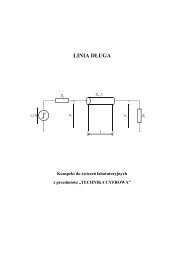9 Interlayer Exchange Interactions in Magnetic Multilayers
9 Interlayer Exchange Interactions in Magnetic Multilayers
9 Interlayer Exchange Interactions in Magnetic Multilayers
You also want an ePaper? Increase the reach of your titles
YUMPU automatically turns print PDFs into web optimized ePapers that Google loves.
344 9 <strong>Interlayer</strong> <strong>Exchange</strong> <strong>Interactions</strong> <strong>in</strong> <strong>Magnetic</strong> <strong>Multilayers</strong><br />
Fig. 4. Cross-section of the Fermi<br />
surface of Cu along the (1 ¯ 10)<br />
plane pass<strong>in</strong>g through the orig<strong>in</strong>.<br />
The solid dots <strong>in</strong>dicate the reciprocal<br />
lattice vectors. The dashed<br />
l<strong>in</strong>es <strong>in</strong>dicate the boundary of the<br />
first Brillou<strong>in</strong> zone. The horizontal,<br />
oblique, and vertical, solid arrows<br />
<strong>in</strong>dicate the vectors q α ⊥ giv<strong>in</strong>g<br />
the oscillation period(s) for<br />
the (001), (111), and (110) orientations,<br />
respectively.<br />
short period are predicted; for the (110) orientation, four different periods are predicted<br />
(only one stationary spann<strong>in</strong>g vector is seen <strong>in</strong> Fig. 4, the three others be<strong>in</strong>g<br />
located <strong>in</strong> other cross-sections of the Fermi surface). These theoretical predictions<br />
have been confirmed successfully by numerous experimental observations. In particular,<br />
the coexistence of a long and a short period for the (001) orientation has been<br />
confirmed for Cu [20–22, 98, 122], Ag [23], and Au [17–19]; and the experimental periods<br />
have been found to be <strong>in</strong> excellent agreement with the theoretical predictions.<br />
Theoretically predicted and experimentally observed oscillation periods <strong>in</strong> Table 1.<br />
Table 1. Comparison of the theoretical predictions of Ref. [117] with experimental observations<br />
of the dependence of oscillation periods of <strong>in</strong>terlayer exchange coupl<strong>in</strong>g on spacer<br />
thickness.<br />
Spacer Theoretical periods System Experimental periods Ref.<br />
Cu(111) = 4.5 AL Co/Cu/Co(111) ≈ 5. AL [118]<br />
Co/Cu/Co(111) ≈ 6. AL [119]<br />
Fe/Cu/Fe(111) ≈ 6. AL [120]<br />
Cu(001) 1 = 2.6 AL<br />
2 = 5.9 AL<br />
Co/Cu/Co(001)<br />
Co/Cu/Co(001)<br />
≈ 6. AL<br />
1 ≈ 2.6 AL<br />
2 ≈ 8. AL<br />
[121]<br />
[20]<br />
Co/Cu/Co(001) 1 ≈ 2.7 AL<br />
2 ≈ 6.1 AL<br />
[22]<br />
Fe/Cu/Fe(001) ≈ 7.5 AL [106]<br />
Ag(001) 1 = 2.4 AL<br />
2 = 5.6 AL<br />
Fe/Ag/Fe(001) 1 ≈ 2.4 AL<br />
2 ≈ 5.6 AL<br />
[23]<br />
Au(001) 1 = 2.5 AL<br />
2 = 8.6 AL<br />
Fe/Au/Fe(001) 1 ≈ 2. AL<br />
2 ≈ 7–8AL<br />
[17]<br />
Fe/Au/Fe(001) 1 ≈ 2.5 AL<br />
2 ≈ 8.6 AL<br />
[18, 19]<br />
Au(111) = 4.8 AL Co/Au/Co(111) ≈ 4.5 AL [14]



